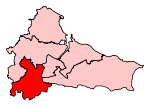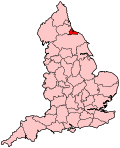Stockton South (UK Parliament constituency)
Coordinates: 54°31′23″N 1°19′19″W / 54.523°N 1.322°W
| Stockton South | |
|---|---|
|
Borough constituency for the House of Commons | |
 Boundary of Stockton South in Cleveland. | |
 Location of Cleveland within England. | |
| County | County Durham, North Yorkshire |
| Electorate | 74,521 (December 2010)[1] |
| Major settlements | Stockton-on-Tees, Thornaby-on-Tees, Yarm, Ingleby Barwick and Eaglescliffe |
| Current constituency | |
| Created | 1983 |
| Member of parliament | Paul Williams (Labour) |
| Number of members | One |
| Created from | Stockton-on-Tees, Thornaby, Easington and Richmond (Yorks)[2] |
| Overlaps | |
| European Parliament constituency | North East England |
Stockton South is a constituency[n 1] represented in the House of Commons of the UK Parliament since June 2017 by Paul Williams, a Labour MP.[n 2]
The seat is one of five won (held or gained) by a Labour candidate in 2017 from a total of six covering the nearby set of local authorities (which each are considered separately by the Boundary Commission in so far as possible without causing great electorate (number of electors) disparity, a concept known as strong malapportionment). Williams' 2017 win was one of 30 net gains of the Labour Party.
The seat has been relative to others a marginal seat since 2005 as well as a swing seat as its winner's majority has not exceeded 9.7% of the vote since the 13.7% majority won in that year. The seat has changed hands twice since that year.
Boundaries
1983–1997: The Borough of Stockton-on-Tees wards of Bishopsgarth, Egglescliffe, Fairfield, Grangefield, Hartburn, Ingleby Barwick, Mandale, Parkfield, Preston, Stainsby, Victoria, Village, and Yarm, and the Borough of Middlesbrough wards of Ayresome, Brookfield, and Kader.
1997–2010: The Borough of Stockton-on-Tees wards of Bishopsgarth, Egglescliffe, Elm Tree, Fairfield, Grangefield, Hartburn, Ingleby Barwick, Mandale, Parkfield, Preston, Stainsby, Victoria, Village, and Yarm. The three Middlesbrough wards were transferred to the redrawn Middlesbrough constituency.
2010–present: The Borough of Stockton-on-Tees wards of Bishopsgarth and Elm Tree, Eaglescliffe, Fairfield, Grangefield, Hartburn, Ingleby Barwick East, Ingleby Barwick West, Mandale and Victoria, Parkfield and Oxbridge, Stainsby Hill, Thornaby-on-Tees, and Yarm.
Stockton South consists of the south-western half of Stockton-on-Tees and on the same bank, upstream, the town of Eaglescliffe – on the southern bank of the River Tees are the towns of Thornaby-on-Tees, Yarm, and Ingleby Barwick.
History
The seat was formed from a combination of Stockton-on-Tees and Thornaby in 1983, predominantly as a replacement to the latter seat.
- Political history
More "middle-class" than neighbouring Stockton North, and first held by the former SDP-Liberal Alliance very narrowly in 1983, then by a Conservative from 1987 for the next ten years, the seat acted as a bellwether in Labour's landslide in 1997 and its member Dari Taylor retained it until the 2010 general election when the Conservative, James Wharton narrowly won the seat. It was the Conservative Party's only gain in the North East, with Wharton substantially increasing his majority in the 2015 general election. However, Labour's victory in the seat in 2017 saw the seat's 30 year status as a bellwether constituency come to an end.
Constituency profile
Based on ONS data, workless claimants and registered jobseekers, were in May 2017 lower than the North East average of 5.9%[3] and also lower than the national average of 4.6%, at 3.4%[4] of the population.
Members of Parliament
| Election | Member[5] | Party | |
|---|---|---|---|
| 1983 | Ian Wrigglesworth | SDP | |
| 1987 | Tim Devlin | Conservative | |
| 1997 | Dari Taylor | Labour | |
| 2010 | James Wharton | Conservative | |
| 2017 | Paul Williams | Labour | |
Elections
Elections in the 2010s
| Party | Candidate | Votes | % | ± | |
|---|---|---|---|---|---|
| Labour | Paul Williams[6] | 26,102 | 48.5 | +11.5 | |
| Conservative | James Wharton | 25,214 | 46.8 | +0.1 | |
| UKIP | David Outterside[7] | 1,186 | 2.2 | -8.4 | |
| Liberal Democrat | Drew Durning | 951 | 1.8 | -0.9 | |
| Green | Jo Fitzgerald | 371 | 0.7 | -1.1 | |
| Majority | 888 | 1.6 | |||
| Turnout | 53,824 | 71.2 | +2.1 | ||
| Labour gain from Conservative | Swing | +5.7 | |||
| Party | Candidate | Votes | % | ± | |
|---|---|---|---|---|---|
| Conservative | James Wharton | 24,221 | 46.8 | +7.8 | |
| Labour | Louise Baldock | 19,175 | 37.0 | -1.3 | |
| UKIP | Ted Strike | 5,480 | 10.6 | +7.7 | |
| Liberal Democrat | Drew Durning | 1,366 | 2.6 | -12.5 | |
| Green | Jacqui Lovell | 952 | 1.8 | +1.8 | |
| Independent | Steve Walmsley | 603 | 1.2 | +1.2 | |
| Majority | 5,046 | 9.7 | |||
| Turnout | 51,797 | 69.0 | |||
| Conservative hold | Swing | +4.55 | |||
| Party | Candidate | Votes | % | ± | |
|---|---|---|---|---|---|
| Conservative | James Wharton | 19,577 | 38.9 | +4.7 | |
| Labour | Dari Taylor | 19,245 | 38.3 | −9.4 | |
| Liberal Democrat | Jacquie Bell | 7,600 | 15.1 | −1.0 | |
| BNP | Neil Sinclair | 1,553 | 3.1 | +3.1 | |
| UKIP | Peter Braney | 1,471 | 2.9 | +0.9 | |
| Independent | Yvonne Hossack | 536 | 1.1 | +1.1 | |
| Christian | Ted Strike | 302 | 0.6 | +0.6 | |
| Majority | 332 | 0.7 | |||
| Turnout | 50,284 | 67.4 | +4.4 | ||
| Conservative gain from Labour | Swing | −7.0 | |||
Elections in the 2000s
| Party | Candidate | Votes | % | ± | |
|---|---|---|---|---|---|
| Labour | Dari Taylor | 21,480 | 47.8 | −5.2 | |
| Conservative | James Gaddas | 15,341 | 34.1 | +1.7 | |
| Liberal Democrat | Mike Barker | 7,171 | 16.0 | +2.4 | |
| UKIP | Sandra Allison | 931 | 2.1 | N/A | |
| Majority | 6,139 | 13.7 | |||
| Turnout | 44,923 | 63.0 | +0.1 | ||
| Labour hold | Swing | −3.5 | |||
| Party | Candidate | Votes | % | ± | |
|---|---|---|---|---|---|
| Labour | Dari Taylor | 23,414 | 53.0 | −2.3 | |
| Conservative | Tim Devlin | 14,328 | 32.4 | −0.6 | |
| Liberal Democrat | Suzanne Fletcher | 6,012 | 13.6 | +4.5 | |
| Socialist Alliance | Lawrence Coombes | 455 | 1.0 | N/A | |
| Majority | 9,086 | 20.6 | |||
| Turnout | 44,209 | 62.9 | −13.1 | ||
| Labour hold | Swing | −0.8 | |||
Elections in the 1990s
| Party | Candidate | Votes | % | ± | |
|---|---|---|---|---|---|
| Labour | Dari Taylor | 28,790 | 56.3 | +16.5 | |
| Conservative | Tim Devlin | 17,205 | 33.7 | −11.5 | |
| Liberal Democrat | Peter Monck | 4,721 | 9.2 | −5.8 | |
| Referendum | John Horner | 400 | 0.8 | +0.8 | |
| Majority | 11,585 | 22.7 | |||
| Turnout | 51,116 | 74.5 | |||
| Labour gain from Conservative | Swing | +14.0 | |||
| Party | Candidate | Votes | % | ± | |
|---|---|---|---|---|---|
| Conservative | Tim Devlin | 28,418 | 45.2 | +10.2 | |
| Labour | John McKie Scott | 25,049 | 39.8 | +8.6 | |
| Liberal Democrat | Kay R. Kirkham | 9,410 | 15.0 | −18.8 | |
| Majority | 3,369 | 5.4 | +4.1 | ||
| Turnout | 62,877 | 82.8 | +3.7 | ||
| Conservative hold | Swing | +0.8 | |||
Elections in the 1980s
| Party | Candidate | Votes | % | ± | |
|---|---|---|---|---|---|
| Conservative | Tim Devlin | 20,833 | 35.0 | −1.6 | |
| Social Democratic | Ian Wrigglesworth | 20,059 | 33.7 | −3.1 | |
| Labour | John McKie Scott | 18,600 | 31.3 | +5.0 | |
| Majority | 774 | 1.3 | |||
| Turnout | 59,492 | 79.0 | +6.9 | ||
| Conservative gain from Social Democratic | Swing | ||||
| Party | Candidate | Votes | % | ± | |
|---|---|---|---|---|---|
| Social Democratic | Ian Wrigglesworth | 19,550 | 36.8 | N/A | |
| Conservative | Tom Finnegan | 19,448 | 36.6 | N/A | |
| Labour | Frank Griffiths | 13,998 | 26.3 | N/A | |
| Independent | D. Fern | 205 | 0.4 | N/A | |
| Majority | 102 | 0.2 | N/A | ||
| Turnout | 53,201 | 72.1 | N/A | ||
| Social Democratic win (new seat) | |||||
See also
Notes
- ↑ A borough constituency (for the purposes of election expenses and type of returning officer)
- ↑ As with all constituencies, the constituency elects one Member of Parliament (MP) by the first past the post system of election at least every five years.
References
- ↑ "Electorate Figures – Boundary Commission for England". 2011 Electorate Figures. Boundary Commission for England. 4 March 2011. Archived from the original on 6 November 2010. Retrieved 13 March 2011.
- ↑ "'Stockton South', June 1983 up to May 1997". ElectionWeb Project. Cognitive Computing Limited. Retrieved 14 March 2016.
- ↑ Office for National Statistics
- ↑ House of Commons Library
- ↑ Leigh Rayment's Historical List of MPs – Constituencies beginning with "S" (part 5)
- ↑ "Local GP named Labour General Election candidate for Stockton South". BNT Media. 1 May 2017. Retrieved 1 May 2017.
- ↑ "David Outterside Tweet". Twitter. 3 May 2017. Retrieved 6 May 2017.
- ↑ "Election Data 2015". Electoral Calculus. Archived from the original on 17 October 2015. Retrieved 17 October 2015.
- ↑ "Stockton South". BBC News. Retrieved 15 May 2015.
- ↑ "Election Data 2010". Electoral Calculus. Archived from the original on 26 July 2013. Retrieved 17 October 2015.
- ↑ "Election Data 2005". Electoral Calculus. Archived from the original on 15 October 2011. Retrieved 18 October 2015.
- ↑ "Election Data 2001". Electoral Calculus. Archived from the original on 15 October 2011. Retrieved 18 October 2015.
- ↑ "Election Data 1997". Electoral Calculus. Archived from the original on 15 October 2011. Retrieved 18 October 2015.
- ↑ "Election Data 1992". Electoral Calculus. Archived from the original on 15 October 2011. Retrieved 18 October 2015.
- ↑ "Politics Resources". Election 1992. Politics Resources. 9 April 1992. Retrieved 6 December 2010.
- ↑ "Election Data 1987". Electoral Calculus. Archived from the original on 15 October 2011. Retrieved 18 October 2015.
- ↑ "Election Data 1983". Electoral Calculus. Archived from the original on 15 October 2011. Retrieved 18 October 2015.